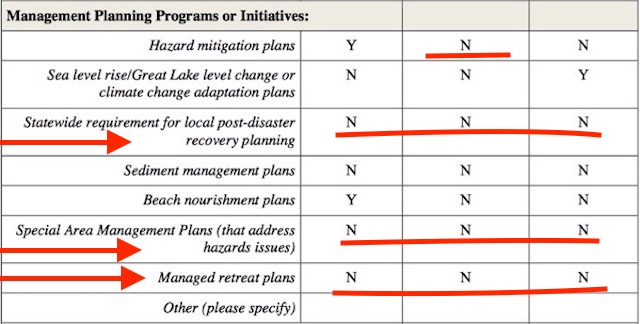NJ Spotlight Relies On Climate Denier In Puff Piece Praising Murphy DEP Lighthouse Project
Another “He said – She said” Story On Climate Chaos
Lighthouse Project Funded By Federal Sandy Disaster Recovery Funds
NJ Received Over $13 Million From This Federal Fund – No State Funding
Sometimes the ironies and contradictions pile up to the point that the situation becomes almost laughable – you can’t make this stuff up.
Today, following a pattern of Murphy DEP news management, finding another “good news” needle in the State DEP’s climate adaptation abdication haystack, NJ Spotlight ran a puff piece, praising the Murphy DEP on a project designed to defend a Delaware Bayshore lighthouse from coastal erosion, storm surge, and flooding caused by climate change, see:
And of course, the Murphy DEP was praised by the lapdog they provide state funding to – who used the opportunity to pitch for more DEP funding of his organization’s pet projects:
Tim Dillingham, executive director of the New Jersey-based American Littoral Society, welcomed the project but said it needs to be followed by a long-term solution.
“The state is to be commended for acting to protect the light, a wonderful, iconic symbol of Delaware Bay’s heritage,” he said. “This is a highly dynamic location which requires a long-term commitment to managing the shoreline changes to ensure the environmental values — horseshoe crab & shorebird habitats — are preserved.”
In addition to finding that good news needle in the Murphy DEP’s climate adaptation abdication and quoting sources with conflicts of interest (i.e. Dillingham, who is funded by DEP), Spotlight quoted a local source that flat out denied climate change and attributed the problem to “natural causes”:
Patterson rejected a suggestion that East Point’s problems are the result of sea-level rise, and argued that “natural erosion” is mainly responsible for eating away at the land surrounding the lighthouse.
“The threat facing East Point is primarily caused by natural erosion — the tide coming in and out around the land known as East Point through the decades,” she said. “Since nothing was ever done to stop the land and beach from washing away, with each tide and various storms through the many decades, the land has badly eroded, leaving the lighthouse susceptible to flooding and very little left to protect it from the waves of the bay.”
I don’t have data, but I suspect that there are a lot of climate deniers in rural Cumberland County that will be reading today’s story.
So why does Spotlight reinforce that ignorance and denial instead of educating the public?
On top of the needle in the haystack and quotes from a climate denier, Spotlight failed to provide critical details about the source of the National park Service funding.
Those details link the money directly to climate change. The damage was exacerbated by climate change. So, the local Cumberland climate denier is biting the hand that fed her (See those details below).
On top of all that, the Murphy DEP received praise, despite the fact that the funding for the project came from the National Park Service and the US Congress.
The National Park Service program that funded the project is called Disaster Recovery Grants:
On occasion, Congress appropriates Emergency Supplemental funding from the Historic Preservation Fund (ESHPF) for recovery from natural disasters, allowing State Historic Preservation Offices (SHPOs) and Tribal Historic Preservation Offices (SHPOs) to work on various recovery projects, including compliance activities, survey and inventory of historic resources in areas impacted by the disaster, recovery and repair of historic properties damaged during the disaster, and other disaster recovery related activities as approved by NPS.
The Disaster Recovery Program – and it was funded by Congress in response to Hurricane Sandy:
Hurricane Sandy Recovery
Grant Total:$47,174,958
SHPOs Awarded:Connecticut, Delaware, Maryland, Massachusetts, New Hampshire, New Jersey, Ohio, Pennsylvania, Rhode Island, West Virginia, Virginia
THPOs Awarded:Narragansett Indian Tribe, Mashantucket (Western) Pequot Tribal NationIn 2013 and 2014, the NPS awarded $47 million to 12 States and two Tribes in the Northeast and Mid-Atlantic regions to assist in historic preservation recovery efforts from Hurricane Sandy in areas where FEMA issued major disaster declarations. The program is still active and final numbers will be posted as grants close.
Sandy damage was magnified by climate change: 1) warmer ocean waters increased the size and intensity of the storm, 2) climate driven sea level rise magnified storm surge, and 3) the path of the storm – i.e. the left turn onto the NJ coast – was influenced by arctic warming.
So the Sandy disaster funds to this lighthouse project were directly related to climate change.
Spotlight also failed to mention that NJ received $13.1 million in these funds, slightly less than New York, who received $13.6 million.
Where did this money go?
How did the Lighthouse project meet this requirement of the federal program?:
- All funded repair work must substantially mitigate the threat and include steps to mitigate future damage.
The story called the project a short term “band aid”. How does such a “band aid” “substantially mitigate the threat” and “include steps to mitigate future damage”?
And finally, the icing on the cake, is that the National Park Service funding is derived from Outer Continental Shelf oil lease revenues, the very fossil fuels that are creating the disasters and climate chaos!
On occasion, Congress appropriates Emergency Supplemental funding from the Historic Preservation Fund (ESHPF) for recovery from natural disasters, allowing State Historic Preservation Offices (SHPOs) and Tribal Historic Preservation Offices (SHPOs) to work on various recovery projects, including compliance activities, survey and inventory of historic resources in areas impacted by the disaster, recovery and repair of historic properties damaged during the disaster, and other disaster recovery related activities as approved by NPS….
The Historic Preservation Fund (HPF), derived from Outer Continental Shelf oil lease revenues, was established in 1977 as the primary source of funding to implement the Federal Preservation Partnership program.
You really can’t make this shit up.

